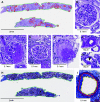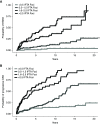Prognostic Implications of a Morphometric Evaluation for Chronic Changes on All Diagnostic Native Kidney Biopsies
- PMID: 35922132
- PMCID: PMC9528338
- DOI: 10.1681/ASN.2022030234
Prognostic Implications of a Morphometric Evaluation for Chronic Changes on All Diagnostic Native Kidney Biopsies
Abstract
Background: Semiquantitative visual inspection for glomerulosclerosis, interstitial fibrosis, and arteriosclerosis is often used to assess chronic changes in native kidney biopsies. Morphometric evaluation of these and other chronic changes may improve the prognostic assessment.
Methods: We studied a historical cohort of patients who underwent a native kidney biopsy between 1993 and 2015 and were followed through 2021 for ESKD and for progressive CKD (defined as experiencing 50% eGFR decline, temporary dialysis, or ESKD). Pathologist scores for the percentages of globally sclerosed glomeruli (GSG), interstitial fibrosis and tubular atrophy (IFTA), and arteriosclerosis (luminal stenosis) were available. We scanned biopsy sections into high-resolution images to trace microstructures. Morphometry measures were percentage of GSG; percentage of glomerulosclerosis (percentage of GSG, ischemic-appearing glomeruli, or segmentally sclerosed glomeruli); percentage of IFTA; IFTA foci density; percentage of artery luminal stenosis; arteriolar hyalinosis counts; and measures of nephron size. Models assessed risk of ESKD or progressive CKD with biopsy measures adjusted for age, hypertension, diabetes, body mass index, eGFR, and proteinuria.
Results: Of 353 patients (followed for a median 7.5 years), 75 developed ESKD and 139 experienced progressive CKD events. Visually estimated scores by pathologists versus morphometry measures for percentages of GSG, IFTA, and luminal stenosis did not substantively differ in predicting outcomes. However, adding percentage of glomerulosclerosis, IFTA foci density, and arteriolar hyalinosis improved outcome prediction. A 10-point score using percentage of glomerulosclerosis, percentage of IFTA, IFTA foci density, and any arteriolar hyalinosis outperformed a 10-point score based on percentages of GSG, IFTA, and luminal stenosis >50% in discriminating risk of ESKD or progressive CKD.
Conclusion: Morphometric characterization of glomerulosclerosis, IFTA, and arteriolar hyalinosis on kidney biopsy improves prediction of long-term kidney outcomes.
Keywords: chronic renal disease; end stage kidney disease; interstitial fibrosis; kidney biopsy; morphometry; renal pathology.
Copyright © 2022 by the American Society of Nephrology.
Figures






References
-
- Chen T, Li X, Li Y, Xia E, Qin Y, Liang S, et al. : Prediction and risk stratification of kidney outcomes in IgA nephropathy. Am J Kidney Dis 74: 300–309, 2019 - PubMed
-
- Ford SL, Polkinghorne KR, Longano A, Dowling J, Dayan S, Kerr PG, et al. : Histopathologic and clinical predictors of kidney outcomes in ANCA-associated vasculitis. Am J Kidney Dis 63: 227–235, 2014 - PubMed
Publication types
MeSH terms
Grants and funding
LinkOut - more resources
Full Text Sources
Medical
Research Materials
Miscellaneous

